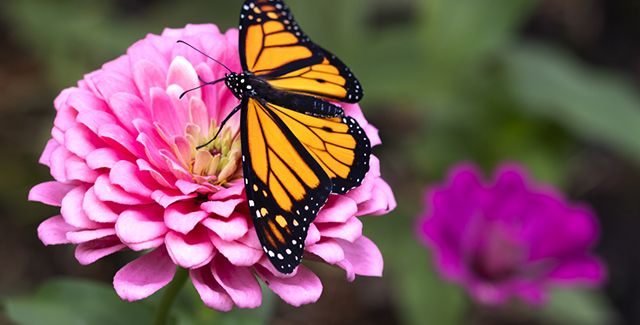Make a Monarch Habitat and Make a Difference

If we do not take action, future generations won’t get the chance to know the beautiful Monarch butterfly like we did.
The Monarch butterfly’s bright orange and black wing colors allow the insect to be easily identifiable. The gorgeous Monarchs are in fact one of the most recognizable species of wildlife. Growing up, many of us remember chasing the butterflies as they fluttered throughout our backyards and gardens. The number of Monarchs throughout North America is dropping dramatically, and if we do not take action, future generations won’t get the chance to know the beautiful Monarch butterfly like we did.
According to the website, http://monarchjointventure.org, pesticides, extreme weather and habitat loss are all to blame for the Monarch population dropping 90 percent over the past decade. One of the biggest threats to Monarch butterflies is the rapid disappearance of milkweed plants. Monarchs cannot survive without milkweed because it is the only plant that females prefer for laying their eggs, and is the only source of food for the caterpillars. The plant also protects the insects after metamorphosis, as the toxins remain in their systems causing them to be poisonous to predators.
How can we help save this beautiful insect? Communities throughout the region can preserve the Monarch population by using their green thumb and simply planting milkweed. Adding milkweed to your landscape not only benefits the Monarchs, but also helps other pollinators survive as well because the plant provides nectar to other butterflies and bees.
Every backyard can become an oasis for Monarchs with these simple gardening tips:
- Ideal gardens should be planted in sunny spots, with protection from harsh winds.
- Plant at least one milkweed species native to your area.
- Include a variety of nectar plants with different bloom times to give butterflies along with other pollinators a continuous food source throughout the year.
- Avoid using herbicides and pesticides, as they are harmful to caterpillars, adult butterflies and milkweed plants.
- Avoid mowing until after butterflies have migrated from the area. Mow in patches to ensure that that the butterflies always have access to undisturbed patches of habitat for survival.
Want to learn more about how you can give your backyard some character and a purpose? Contact Joe’s Market Basket for more tips and information on creating a Monarch habitat. Visit us at any of our four locations in Edwardsville, Godrey, O’Fallon and Troy, Illinois or give us a call at (618) 656-9055.


